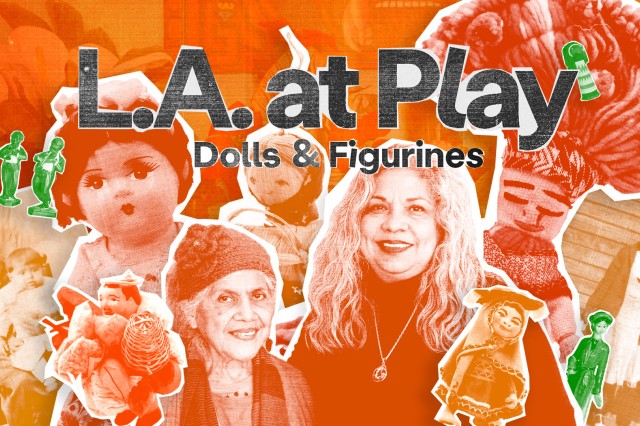
STORY
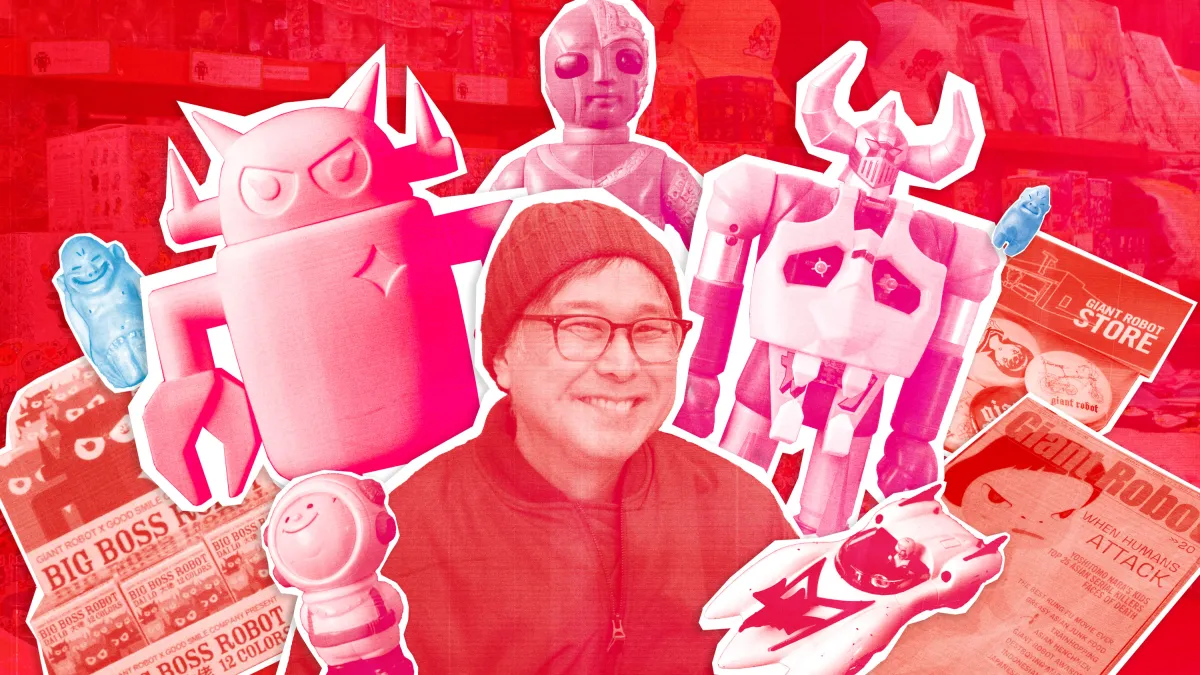
Publisher, designer, toy maker, gallery curator, artist, photographer—all correct answers to the question, “What does Eric Nakamura do?” Despite the multifaceted nature of his work, there exists a simple unifying factor. According to Eric, “ It’s just making something that’s really cool or something that you’ve dreamed about and just going for it.” Eric’s creative and community work is a testament to the fact that play inhabits not just the realm of children, it's also an art form.
Now…we can actually, you know, find ways to make things that you've always dreamed of making
Eric Nakamura
Born and raised in West Los Angeles, Eric’s constant companions were notepads, sketchbooks, pens and pencils, and drawing an incessant urge. Eventually, Eric channeled his love of design and Asian popular culture into a zine called Giant Robot. Eric published and co-edited the zine during its entire run from 1994 to 2010, and during that time it garnered a devoted following. The 68 issues of Giant Robot were highly regarded for being the premier magazine focused on both Asian and Asian-American pop culture and also prominently featuring contemporary art and artists. Eric parlayed the success of the zine into stores and art galleries on both coasts and now he owns and works at Giant Robot Store and GR2 gallery in West Los Angeles.
We sat down with Eric at his Giant Robot Store to talk about his creative process, his inspirations, and the unique connection he has to Los Angeles. Click here or on the link above to watch Eric talk about his own creations and his inspirations.
Eric Nakamura has spent his entire life in West Los Angeles. By his own admission, “I haven’t lived very far east of the 405, ever.” Even today, his Giant Robot Store and GR2 gallery are located on the historic Sawtelle Boulevard in West LA. Sawtelle Boulevard is especially meaningful to Eric because his parents met on Sawtelle in the sixties. Locations central to young Eric’s life also were just off of Sawtelle: his Japanese elementary school, the local Buddhist temple, and his grandmother’s house. In 2001, seeking a storefront for the Giant Robot brand and eventually a separate gallery space, Eric acquired two storefronts on Sawtelle just a few blocks from where he grew up.
It’s just an amalgamation of so many different things from everywhere [that] make this a giant robot L.A. kind of vibe
Eric Nakamura
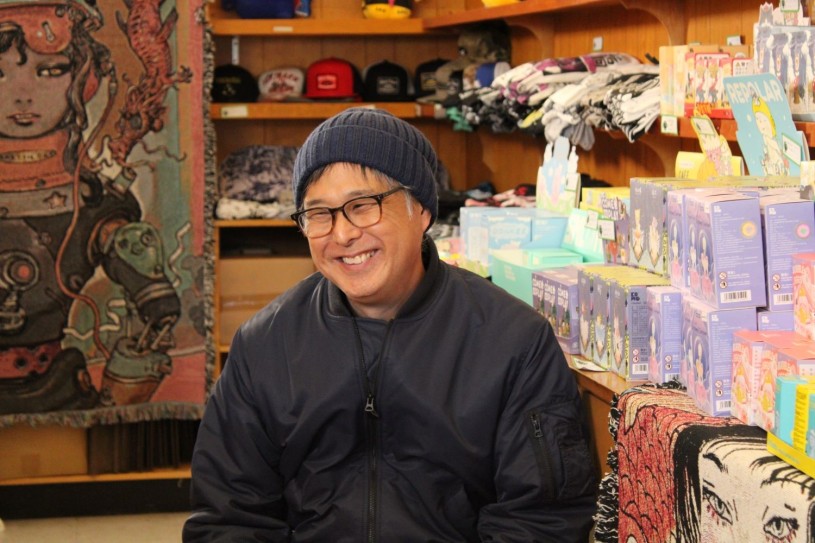
A portion of Sawtelle Boulevard is officially designated as one of California’s four Japantowns, a region of a city where Japanese business and cultural resources are grouped. Sawtelle Japantown is a vibrant hub of Japanese and other Asian-American cultures, and it is within this cultural environment that Eric was exposed to the Japanese pop culture aesthetic that would come to define his personal creations and his curation style.
As any artist knows, L.A. is fertile ground for collaboration. This geographic confluence of worldwide creatives is what Eric cites as making Giant Robot uniquely L.A. “It’s all about the people, its community 100%,” Eric continues, “If that wasn't there, then it would be so less interesting and less fun and not inspiring at all.”
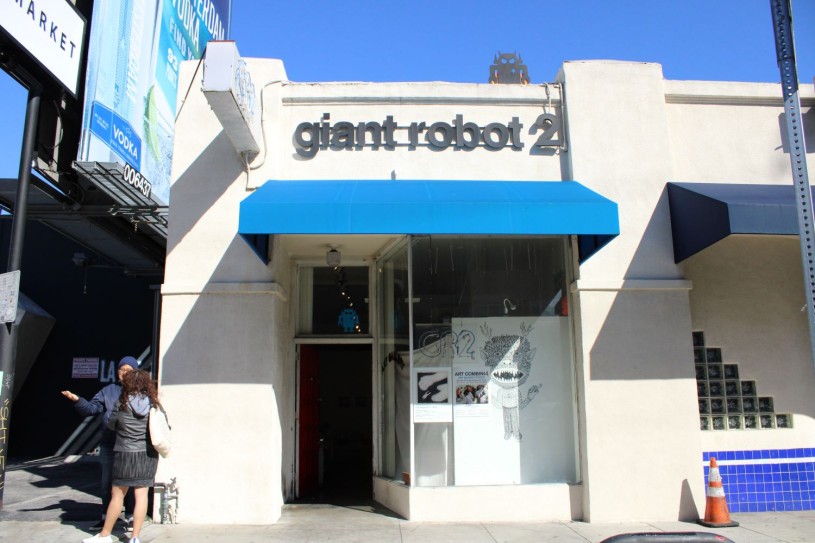
The eclectic collection of art, books, figurines, toys, and clothing at Giant Robot Store and GR2 gallery is what Eric hopes will continue to attract and inspire members of the community of all ages for decades to come.
The toys that Eric designs himself have a unique aesthetic that is typified by that of robots in Japanese cartoons, or anime, and special effects-driven live-action superhero series, called tokusatsu (“special-filming”) from the 1970s. Also prominent in his designs is the influence of mecha anime and manga, or stories where the protagonists are larger-than-life robots either autonomous or piloted by humans. Speaking about these early influences, Eric remembered, “They always had horns and they could fly and they could do all these different things. And I wanted to make a robot that’s a little more cartoony.”
Thus was born Big Boss Robot, Eric’s flagship character, and Giant Robot mascot. In this section, we take a closer look at not only Big Boss Robot but also the toys that inspired its creation. Click through the images below to learn more about the toys and shows that inspire Eric’s designs.
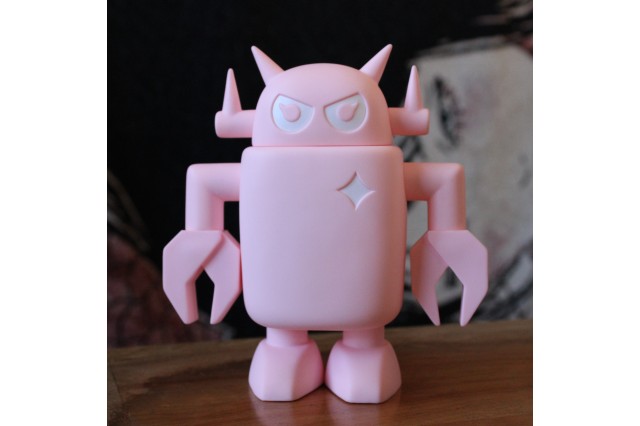
Natural History Museum of Los Angeles County
The design of Big Boss Robot is directly inspired by a combination of both its metal robot counterparts and also vintage vinyl plastic Japanese toys. Eric recounts, “The vinyl toys were always puffy and kind of odd…I wanted to make something cute.” The angular proportion of its headgear and clawed arms are typical of die-cast Japanese robot toys of the 70s, while the chunky footwear and the inflated body style are hallmarks of the non-metallic vinyl toys of the same era.
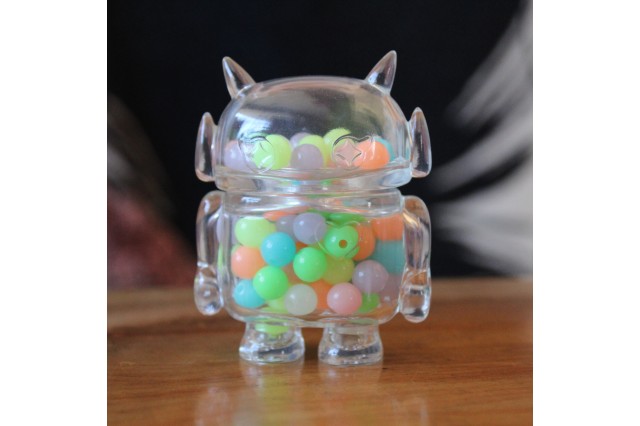
Natural History Museum of Los Angeles County
This translucent, bead-filled Big Boss Robot sports a heart on its chest rather than a throwing star.
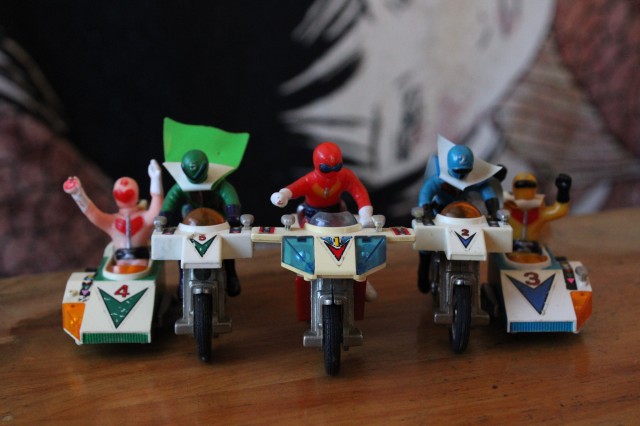
Natural History Museum of Los Angeles County
These are the Gorangers, a group of five humans endowed with superhuman powers through their futuristic super suits. Himitsu Sentai Gorenjā, or Secret Squad Goranger, was a live-action television series that ran during the mid 1970s in Japan. The Gorangers were the first of the Super Sentai Series, a designation given to the genre of interrelated live action shows that centered around teams of heroes who join forces to defeat the forces of evil. In 1993, the influence of the Japanese Super Sentai series, dating back to the original Gorangers, would be felt by millions of American viewers with the debut of the Mighty Morphin Power Rangers.
Natural History Museum of Los Angeles County
Gurēto Majingā, or Great Mazinger, is a supersized robot made by humans to be used against the forces of evil, namely Dr. Hell’s mechanical beasts. Great Mazinger debuted as a sequel to the manga and anime series Mazinger Z and ran from 1974 to 1975.
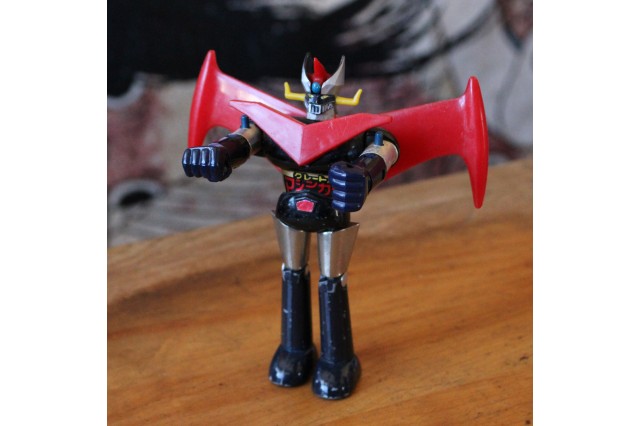
Natural History Museum of Los Angeles County
Another iteration of the Great Mazinger, this time with launchable robo-fists.
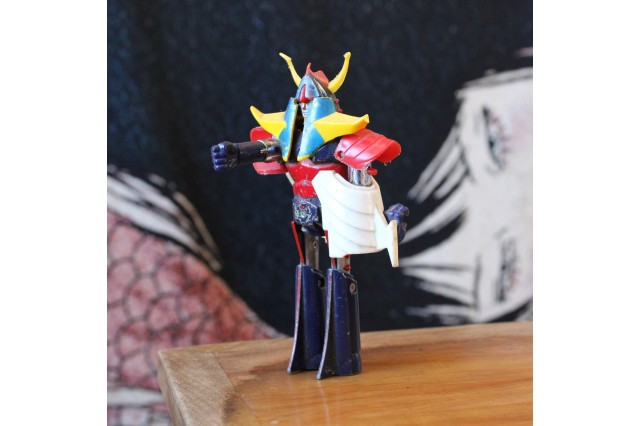
History Museum of Los Angeles County
The ancient super-robot Raideen stands ready to protect Earth from the Demon Empire. Yūsha Raidīn, or Brave Raideen, was a Japanese cartoon that originally aired from 1975 to 1976.
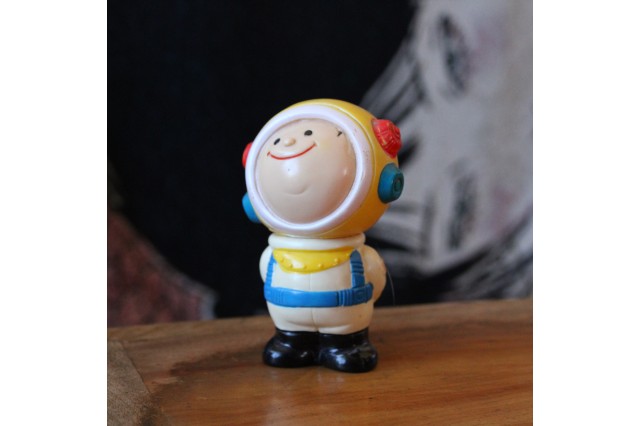
Natural History Museum of Los Angeles County
This brave space traveler is called Maruchan, literally meaning “round head”. Maruchan was a novelty item given to customers of a Japanese bank.
Natural History Museum of Los Angeles County
Always seeming to be in motion even while stationary, this is a die-cast toy of racecar driver Gō Mifune, also known as Speed Racer. Speed Racer first appeared in Japanese print comics, or manga, as Mach GoGoGo by Tatsuo Yoshida which in turn spawned the animated cartoon, or anime, in 1968. A feature length American film adaptation of Speed Racer was made in 2008, a testament to Racer’s enduring popularity.
Natural History Museum of Los Angeles County
In 1972, the Japanese tokusatu series Jinzô ningen Kikaidâ, or Kikaida: Android of Justice, first introduced the world to Kikaida, the Janus-faced superhero who is ever vigilant in the fight against the Destructoids. Kikaida: Android of Justice was among the first tokusatsu shows to be broadcast in the United States, garnering a legion of devoted fans in Hawaii and creating a lasting fondness for the multicolored android that persists to this day.
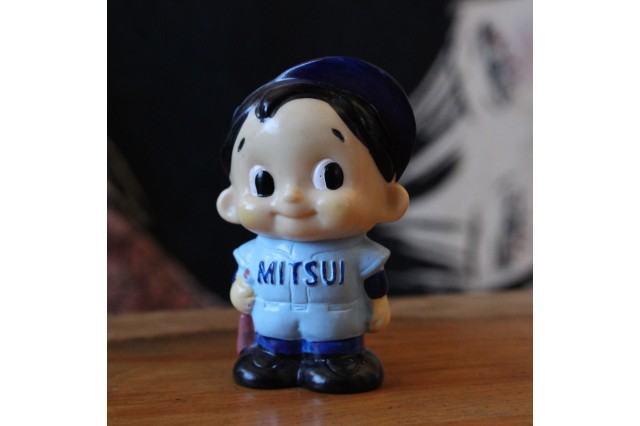
Natural History Museum of Los Angeles County
This precocious ballplayer doubles coin bank, a novelty gift courtesy of Mitsui Bank in Japan.
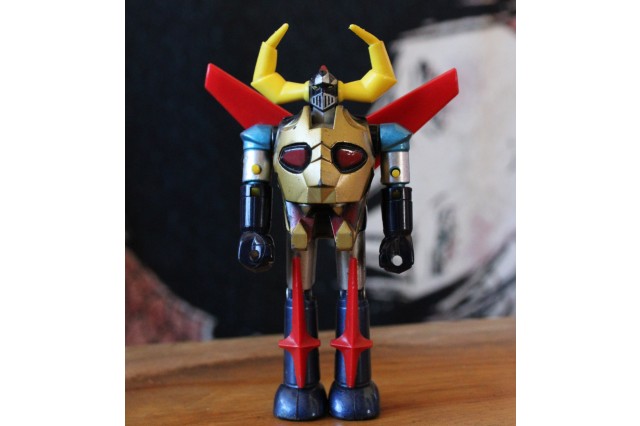
Natural History Museum of Los Angeles County
With chest armor that evokes a mechanical dragon, this imposing mecha is called Gaiking, built to protect the world from the Dark Horror Army of aliens. Gaiking premiered in the anime Daikū Maryū Gaikingu, or Sky Devilsaur Gaiking, which ran in Japan from 1976 to 1977.
Natural History Museum of Los Angeles County
Pictured here is supersized Gaiking, complete with extra large launchable fists. Gaiking, along with Raideen and the Great Mazinga, were a part of Mattel’s Shogun Warrior toy line. Mattel licensed these toys for import into the United States, selling 3.5, 5, and 24-inch versions of these mecha heroes.
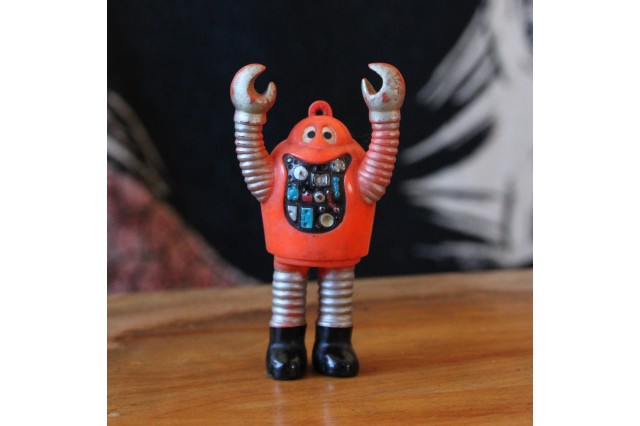
Natural History Museum of Los Angeles County
This genial looking robot is Robocon, the title character in a Japanese live action family comedy from the 1970s called Ganbare!!Robocon. The titular Robocon is a student sent from a robot academy to live amongst humans on Earth. While he often is prone to folly, his ultimate goal is to help humankind and to be a force for good.

Natural History Museum of Los Angeles County
Gantsu Sensei, another character from anime Ganbare!!Robocon, is the head teacher at the robot academy that Robocon attends.
1 of 1
The design of Big Boss Robot is directly inspired by a combination of both its metal robot counterparts and also vintage vinyl plastic Japanese toys. Eric recounts, “The vinyl toys were always puffy and kind of odd…I wanted to make something cute.” The angular proportion of its headgear and clawed arms are typical of die-cast Japanese robot toys of the 70s, while the chunky footwear and the inflated body style are hallmarks of the non-metallic vinyl toys of the same era.
Natural History Museum of Los Angeles County
This translucent, bead-filled Big Boss Robot sports a heart on its chest rather than a throwing star.
Natural History Museum of Los Angeles County
These are the Gorangers, a group of five humans endowed with superhuman powers through their futuristic super suits. Himitsu Sentai Gorenjā, or Secret Squad Goranger, was a live-action television series that ran during the mid 1970s in Japan. The Gorangers were the first of the Super Sentai Series, a designation given to the genre of interrelated live action shows that centered around teams of heroes who join forces to defeat the forces of evil. In 1993, the influence of the Japanese Super Sentai series, dating back to the original Gorangers, would be felt by millions of American viewers with the debut of the Mighty Morphin Power Rangers.
Natural History Museum of Los Angeles County
Gurēto Majingā, or Great Mazinger, is a supersized robot made by humans to be used against the forces of evil, namely Dr. Hell’s mechanical beasts. Great Mazinger debuted as a sequel to the manga and anime series Mazinger Z and ran from 1974 to 1975.
Natural History Museum of Los Angeles County
Another iteration of the Great Mazinger, this time with launchable robo-fists.
Natural History Museum of Los Angeles County
The ancient super-robot Raideen stands ready to protect Earth from the Demon Empire. Yūsha Raidīn, or Brave Raideen, was a Japanese cartoon that originally aired from 1975 to 1976.
History Museum of Los Angeles County
This brave space traveler is called Maruchan, literally meaning “round head”. Maruchan was a novelty item given to customers of a Japanese bank.
Natural History Museum of Los Angeles County
Always seeming to be in motion even while stationary, this is a die-cast toy of racecar driver Gō Mifune, also known as Speed Racer. Speed Racer first appeared in Japanese print comics, or manga, as Mach GoGoGo by Tatsuo Yoshida which in turn spawned the animated cartoon, or anime, in 1968. A feature length American film adaptation of Speed Racer was made in 2008, a testament to Racer’s enduring popularity.
Natural History Museum of Los Angeles County
In 1972, the Japanese tokusatu series Jinzô ningen Kikaidâ, or Kikaida: Android of Justice, first introduced the world to Kikaida, the Janus-faced superhero who is ever vigilant in the fight against the Destructoids. Kikaida: Android of Justice was among the first tokusatsu shows to be broadcast in the United States, garnering a legion of devoted fans in Hawaii and creating a lasting fondness for the multicolored android that persists to this day.
Natural History Museum of Los Angeles County
This precocious ballplayer doubles coin bank, a novelty gift courtesy of Mitsui Bank in Japan.
Natural History Museum of Los Angeles County
With chest armor that evokes a mechanical dragon, this imposing mecha is called Gaiking, built to protect the world from the Dark Horror Army of aliens. Gaiking premiered in the anime Daikū Maryū Gaikingu, or Sky Devilsaur Gaiking, which ran in Japan from 1976 to 1977.
Natural History Museum of Los Angeles County
Pictured here is supersized Gaiking, complete with extra large launchable fists. Gaiking, along with Raideen and the Great Mazinga, were a part of Mattel’s Shogun Warrior toy line. Mattel licensed these toys for import into the United States, selling 3.5, 5, and 24-inch versions of these mecha heroes.
Natural History Museum of Los Angeles County
This genial looking robot is Robocon, the title character in a Japanese live action family comedy from the 1970s called Ganbare!!Robocon. The titular Robocon is a student sent from a robot academy to live amongst humans on Earth. While he often is prone to folly, his ultimate goal is to help humankind and to be a force for good.
Natural History Museum of Los Angeles County
Gantsu Sensei, another character from anime Ganbare!!Robocon, is the head teacher at the robot academy that Robocon attends.
Natural History Museum of Los Angeles County
Eric’s designs and toy creations are partly a product of the exchange of artistic inspiration across cultures through popular media. In this case, Eric was inspired by the vibrant style of Japanese manga and anime and used key elements of that wildly eclectic style in his own art. There lives in the Natural History Museum’s anthropological research collections a small ivory charm that was also the byproduct of a cross-cultural exchange of ideas, and although this one was not inspired by any ancient mecha super-robots, it became so popular around the world that to this day it remains in use as a token of good fortune.
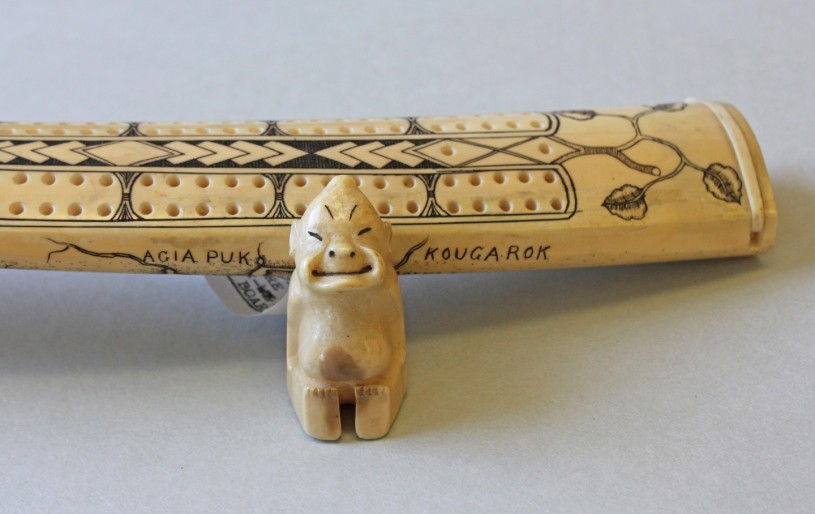
This enigmatic good-luck charm is called a Billiken, and although the examples in our collection are from Northern Alaska, the story of the Billiken can be traced back to an art teacher living in Kansas City, Missouri, in 1909. Click through the photos below to trace the globe-trotting history of this mysterious bringer of good fortune.
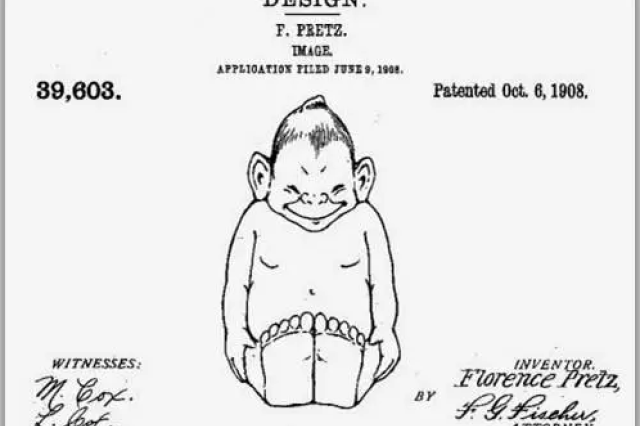
US Patent Office/Saint Louis University Archives
In October of 1908, a young art teacher and illustrator living in Kansas City named Florence Pretz filed a patent for a design, by some accounts inspired by a dream, meant to embody good fortune.
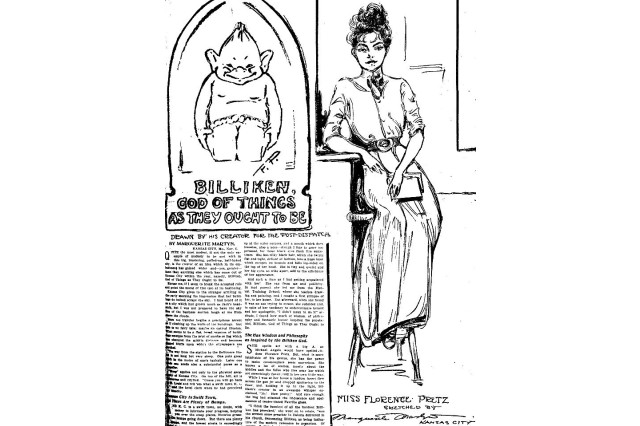
Public Domain
The Billiken, whose name comes from a fantastical 1896 poem called, “Mr. Moon: A Song of the Little People”, was designed by Pretz to be the patron deity of, “things as they ought to be”. Pretz and her design are profiled in this magazine article from 1909.
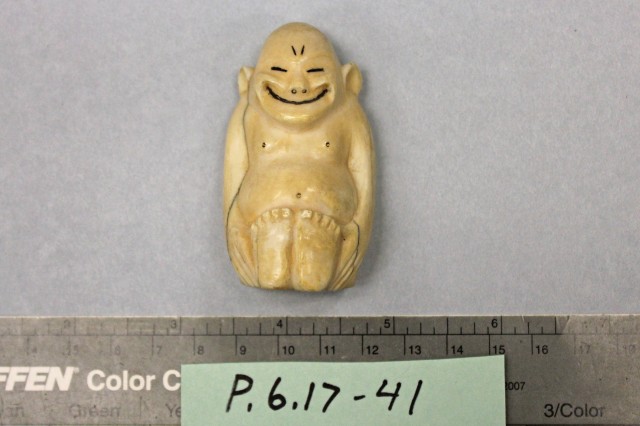
Natural History Museum of Los Angeles County, Anthropology Collection: Ethnology
Shortly after patenting her design, Florence sold the rights to Billiken’s design to a manufacturing company. By 1911 Billiken-mania was in full swing. The smiling “god of things as they ought to be'' decorated candy tins, hood ornaments, packaging, pins, and myriad tchotchkes. Indigenous Inuit artisans in Alaska began to carve the good luck charms out of local materials like walrus ivory. Handmade Billiken charms are still widely available in parts of Alaska.
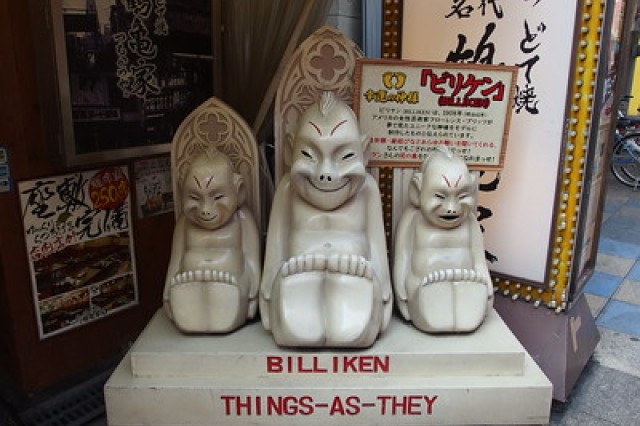
Courtesy of Guilhem Vellut via Flickr/ https://www.flickr.com/photos/o_0/
Eventually, the Billiken made its way to Japan. Shop owners and restaurants displayed statues of the grinning gods entice people with the promise of good fortune. Good fortune is attained by rubbing the feet or belly of the Billiken. This trio of Billiken are proudly displayed in a shopping center in Osaka, Japan.
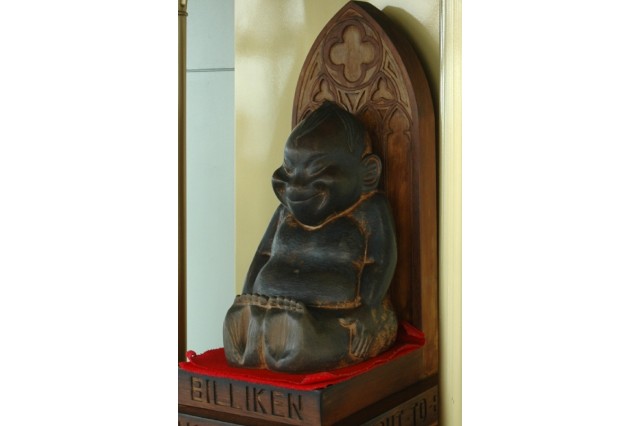
Public Domain
During a period of anti-American sentiment during World War II, many Billiken figures were destroyed or hidden away. Following the reestablishment of peacetime relations, Billiken were again prominently displayed in storefronts, restaurants, and even in shrines. This famous wooden Billiken sits on the fifth floor observation deck in Tsutenkaku Tower in Osaka, Japan, beckoning visitors to rub its feet for good luck.
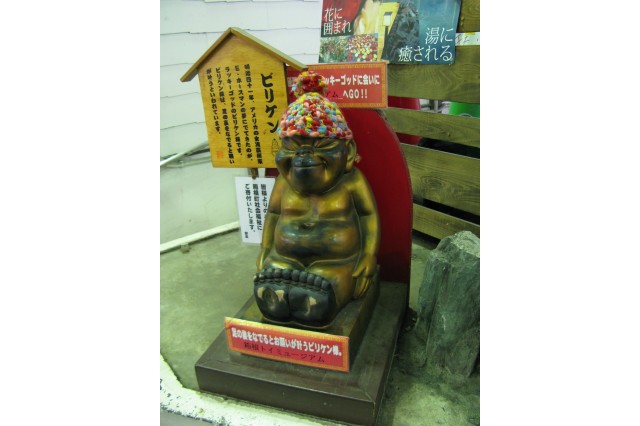
Courtesy of Clanchou via flickr/ https://www.flickr.com/photos/clanchou/
This Billiken sits in the Hakone-Yumoto Train Station in Kanagawa Prefecture, Japan. Notice the statue’s blackened feet and belly, the result of legions of passengers imploring the Billiken for good fortune.
1 of 1
In October of 1908, a young art teacher and illustrator living in Kansas City named Florence Pretz filed a patent for a design, by some accounts inspired by a dream, meant to embody good fortune.
US Patent Office/Saint Louis University Archives
The Billiken, whose name comes from a fantastical 1896 poem called, “Mr. Moon: A Song of the Little People”, was designed by Pretz to be the patron deity of, “things as they ought to be”. Pretz and her design are profiled in this magazine article from 1909.
Public Domain
Shortly after patenting her design, Florence sold the rights to Billiken’s design to a manufacturing company. By 1911 Billiken-mania was in full swing. The smiling “god of things as they ought to be'' decorated candy tins, hood ornaments, packaging, pins, and myriad tchotchkes. Indigenous Inuit artisans in Alaska began to carve the good luck charms out of local materials like walrus ivory. Handmade Billiken charms are still widely available in parts of Alaska.
Natural History Museum of Los Angeles County, Anthropology Collection: Ethnology
Eventually, the Billiken made its way to Japan. Shop owners and restaurants displayed statues of the grinning gods entice people with the promise of good fortune. Good fortune is attained by rubbing the feet or belly of the Billiken. This trio of Billiken are proudly displayed in a shopping center in Osaka, Japan.
Courtesy of Guilhem Vellut via Flickr/ https://www.flickr.com/photos/o_0/
During a period of anti-American sentiment during World War II, many Billiken figures were destroyed or hidden away. Following the reestablishment of peacetime relations, Billiken were again prominently displayed in storefronts, restaurants, and even in shrines. This famous wooden Billiken sits on the fifth floor observation deck in Tsutenkaku Tower in Osaka, Japan, beckoning visitors to rub its feet for good luck.
Public Domain
This Billiken sits in the Hakone-Yumoto Train Station in Kanagawa Prefecture, Japan. Notice the statue’s blackened feet and belly, the result of legions of passengers imploring the Billiken for good fortune.
Courtesy of Clanchou via flickr/ https://www.flickr.com/photos/clanchou/
Today, the Billiken is ubiquitous in parts of Alaska, Japan, and Missouri, where it remains the mascot of St. Louis University. The story of the Billiken is illustrative of the power of art and design to bring people together across cultures. Florence Pretz patented the Billiken with the intent of spreading joy and positivity to those who looked upon it. Similarly, Eric Nakamura, a hundred years later and two thousand miles away, also is driven by that same idea. When asked what drives him to create things, Eric said, “It's just about seeing if it makes people happy or excited or inspired; that’s everything to me.” He elaborated, “I don't know if I can compare it to a zombie apocalypse. I'm trying to find the other humans trying to survive, and I'm looking for them all to connect them and let's make a better world…Let's get together, you know, let's make stuff.”
The L.A. at Play story is not complete without you! Share your creature, doll, or figurine story and follow the stories of the makers who are contributing to some of L.A.'s most iconic fandoms. Tag us @NHMLA with #LAatPlay
To see what's happening at Giant Robot, go to giantrobot.com or visit them at both locations on Sawtelle Blvd in West Los Angeles. The Giant Robot Store is located at 2015 Sawtelle Blvd, Los Angeles, CA 90025 and the GR2 Gallery is located at 2062 Sawtelle Blvd, Los Angeles, CA 90025.